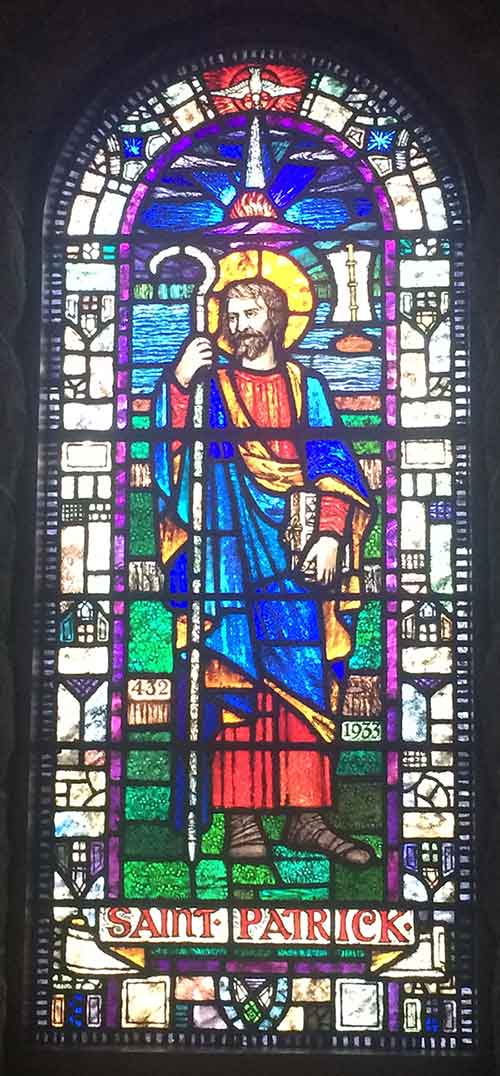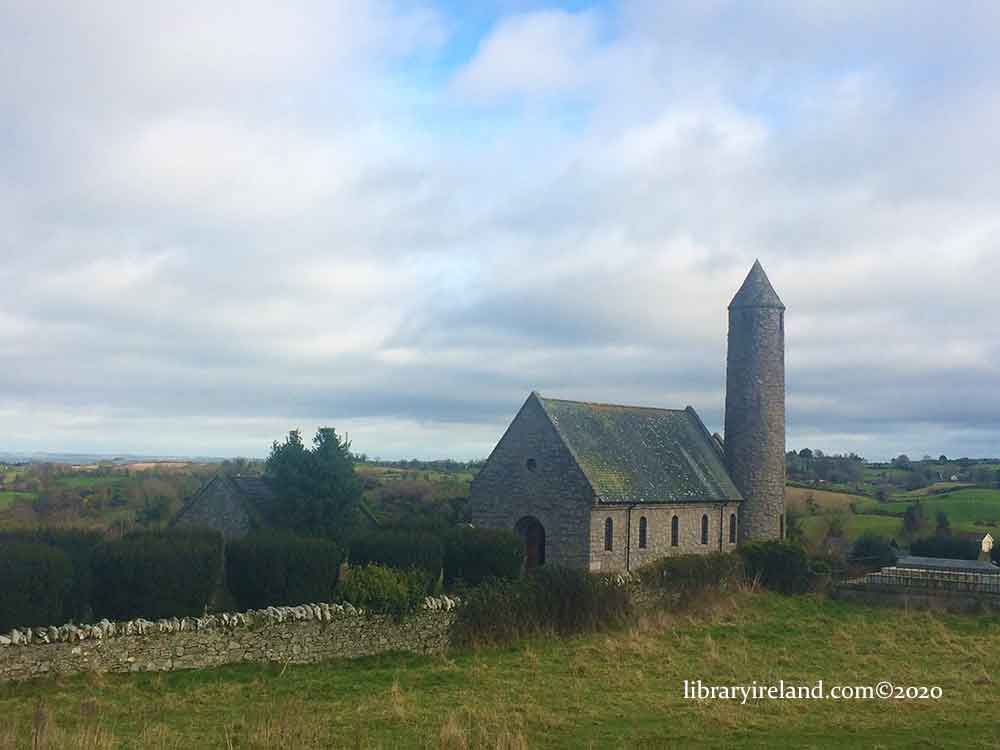Saint Patrick
The sub-headings have been added to the original entry for navigation purposes. Images are also not part of the original work.
Patrick, Saint. [Ireland, England, Scotland, Wales, and France have claimed the honour of giving birth to St. Patrick, and the date of his birth is variously set down in the years 250, 372, 373 and 387. Dr. Todd’s Life of St. Patrick is here followed.]
He was born at Dumbarton, on the Clyde, in 373, and was the son of Calpurnius, a deacon, and Conchessa his wife, daughter of Ochinus, a Frank.
His original name was Succat.

Stained glass window of Saint Patrick in Saul Church, County Down
The captivity and enslavement of Patrick
When about sixteen he was carried captive into Ireland “with many thousands of men.”
There he was employed by his master, Milchu, to tend cattle on the mountain of Slieve Mis, in Antrim.
In the quiet of the woods he states that he was every day in frequent prayer, and that the love and fear of God increased so much, and the spirit of prayer so grew upon him, that often in a single day he would say one hundred prayers, and in the night almost as many, so that he frequently arose to prayer in the woods and mountains before daylight, in snow, and frost, and rain; and “I felt no evil, nor was there any laziness in me, because, as I now see, the spirit was burning within me.”
Patrick’s escape and visions
One night, after he had been six years in slavery, and when he was twenty-two years of age, he heard a voice saying to him—“Thy fasting is well; thou shalt soon return to thy country.”
Again he had a dream, in which the same voice told him that the ship was ready, but was distant 200 miles.
He immediately fled from his master, went to the port indicated, and after some difficulty obtained a passage in a vessel.
He was three days at sea, and afterwards a considerable time wandering in a desert before he reached human habitations.
He was joyfully received by his relatives, who earnestly besought him not to expose himself to fresh dangers, but to remain with them for the rest of his life.
Patrick, however, soon felt constrained to devote himself to the conversion of the Irish. He had another vision:
“In the dead of night, I saw a man coming to me as if from Hiberio, whose name was Victorius, bearing innumerable epistles, and he gave me one of them, and I read the beginning of it, which contained the words, ‘The voice of the Irish.’ And whilst I was repeating the beginning of the epistle, I imagined that I heard in my mind the voice of those who were near the wood of Fochlut, which is near the Western Sea. And thus they cried—‘We pray thee, holy youth, to come, and henceforth walk amongst us.’ And I was greatly pricked in heart, and could read no more; and so I awoke. Thanks be to God, that after very many years the Lord granted unto them the blessing for which they cried.”
This and similiar visions impelled him to return at all hazards to Ireland, and endeavour to convert his former associates to Christianity.
Patrick’s return to Ireland
The date of his second visit (whether specially commissioned from Rome or not) is generally put down at 432.
He landed in the territory of Cuolenni, near where the town of Bray, in the County of Wicklow, is now situated; but desiring to see his old master, Milchu, and offer him eternal life in return for having left his service, he took shipping again and sailed north—visiting and giving his name (Inis Patrick) to one of the Skerries.
He and his companions landed at the mouth of the river Slain in Strangford Lough. There they hid their boat and proceeded to explore the country.
Their first convert was Dichu, a chieftain of high birth, who entertained them hospitably.
Milchu sets fire to his house
Proceeding on his way he came in view of the habitatation of his old master, only to see it in flames.
The narrative tells how Milchu, instigated by the Devil, set fire to his house and all his substance, and threw himself into the flames, rather than submit to the authority and jurisdiction of his former slave.
St. Patrick at Lecale
St. Patrick then retraced his steps to Magh-inis (Lecale) where his friend Dichu resided, and spent some time teaching and preaching in the neighbourhood. There the faith first began to spread.
St. Patrick at Tara
Having thus laid the foundation of Christianity in the north, he determined to celebrate Easter at Tara, and accordingly went by sea to the mouth of the Boyne, and proceeded on foot up the valley to the seat of the supreme power in Ireland.
At Slane he lighted his Paschal fire. It was the season when, according to pagan custom, every light throughout the country should be extinguished.
St. Patrick’s fire, seen from Tara, caused astonishment and indignation, and the Ard Righ demanded who was guilty of such presumption.
The druids declared that it was a light that unless immediately extinguished would last for ever.
St. Patrick was summoned into the King’s (Laoghaire’s) presence.
Then we are told of a contest between St. Patrick and the King’s druids, evidently suggested by the Old Testament narrative of the conflict between Elijah and the priests of Baal.
The Saint discomfited the druids, and next day preached before the King and his court.
On this occasion he is said first to have recited his hymn, commencing:
“I bind to myself to-day the strong power of an invocation of the Trinity, the faith of the Trinity in unity, the Creator of the elements.”
Dr. Todd says that “internal evidence is in favour of the antiquity and authenticity of this composition.”
St. Patrick, although making a strong impression upon many members of the court, was unable to convert Laoghaire himself, who ended his life a pagan.
Yet no opposition was made to his freely preaching and teaching throughout the country. Christianity was gladly accepted; churches began to rise on every side, and teachers and bishops were consecrated.
Conversion of Princesses Ethne and Fedelm
The Book of Armagh gives an extremely interesting account of St. Patrick’s interview with the Princesses Ethne and Fedelm, hard by a fountain on the side of Cruachan, in Roscommon, and of the discussion between them regarding Christianity.
He spent altogether seven years in Connaught before revisiting Ulster, and then proceeded southwards through Meath, by Naas, and on to Wicklow.
Retracing his steps, he founded churches in Ossory, and journeyed to Cashel.
St. Patrick spent seven years in Munster.
Founding of Armagh
About 445 he founded Armagh—the chief Daire presenting to him the site for the city, together with the rights of chieftainship, which descended to his successors in the see, and contributed to the subsequent ecclesiastical importance of the place.
Senchus Mor
St. Patrick next proceeded to reform the ancient druidical and pagan laws of Ireland, and made the beginning of the collection now known as the Senchus Mor, sometimes called Cain Patraic—Patrick’s Law.
In 460 he called a synod for the purpose of enacting canons for the government of the Church.
The year 493 is generally accepted as the date of his death, which probably occurred at Saul, in the present County of Down. He is believed to have been buried at Downpatrick.

Saul Church, County Down
Dr. James Henthorn Todd on St. Patrick
Dr. Todd, in concluding his biography, writes:
“On the whole, the biographers of St. Patrick, notwithstanding the admixture of much fable, have undoubtedly pourtrayed in his character the features of a great and judicious missionary. He seems to have made himself ‘all things,’ in accordance with the apostolic injunction, to the rude and barbarous tribes of Ireland. He dealt tenderly with their usages and prejudices. Although he sometimes felt it necessary to overturn their idols, and on some occasions risked his life, he was guilty of no offensive or unnecessary iconoclasm. A native himself of another country, he adopted the language of the Irish tribes, and conformed to their political institutions.”
The Confession of St. Patrick
Concerning his Confession Dr. Todd says:
“It is older than any of the extant biographies of the Saint, for they almost all quote and adopt its words; a copy of it was transcribed at the end of the 8th or very early in the 9th century into the collection called the Book of Armagh. This copy professes to have been taken from the autograph of St. Patrick. … It was certainly transcribed from a manuscript which even in the year 800 was beginning to become obscure, and of whose obscurities the transcriber more than once complains. It possesses, therefore, no mean external evidence of authenticity.”
The Confession was first printed by Sir James Ware in 1656. Dr. Lanigan unhesitatingly accepts what Dr. Todd doubts—the account of St. Patrick having been appointed by Pope Celestine to visit Ireland as an assistant to Palladius.
St. Patrick’s bell
A bell and portions of manuscript believed to have belonged to the Saint are preserved in the museum of the Royal Irish Academy.
Doubts surrounding the dates of St. Patrick
Mr. Nicholson, basing his argument upon passages in the Confession, the fact of there having been many Christians in Ireland at the date assigned to the Saint’s advent, and the legends of conferences between Ossian and St. Patrick, has arrived at the conclusion that St. Patrick lived in the 3rd, not the 5th century.
Numerous references to St. Patrick will be found in all the series of Notes and Queries.
Festival date for St. Patrick
His festival is the 17th March.
Sources
119. Ecclesiastical History of Ireland: Rev. John Lanigan. 4 vols. Dublin, 1822.
254. Notes and Queries. London, 1850–’78.
O’Callaghan, John C., see No. 186.
279. Patrick, Saint, Apostle of Ireland, his Life and Mission: Rev. James H. Todd, D.D. Dublin, 1864.
280. Patrick, Saint, Apostle of Ireland in the Third Century: R. Steele Nicholson. Dublin, 1868.
